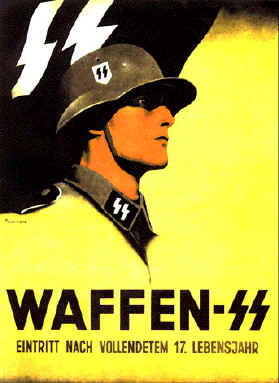THE WAFFEN SS



The Waffen-SS were the armed units of the Schutzstaffel, better known as the SS. The SS were the protective guards of the National Socialist German Workers Party (NSDAP) - or the “Nazis.” Many soldiers in the Waffen-SS distinguished themselves in combat, and in a small number of cases, became notorious for their atrocities. However, these crimes against humanity should not label the entire Waffen-SS as an organization of hate. The vast majority of soldiers were combatants, not criminals.
This apolitical site is to explore the combat role of the Waffen-SS in World War II.
HISTORY OF WAFFEN SS:
History of the Waffen-SS
In 1933, the Schutzstaffel organized a full-time armed branch called the SS-Verfügungstruppen (SS-VT). These units were placed at Hitler's disposal, and were intended to be special purpose troops for such duties as putting down counterrevolutions and strikes, conduct purges, and quell riots. By 1939, the size of the SS-VT expanded to four regiments (Standarten), due to the usefullness of having combat units outside the control of the German military. These soldiers were carefully selected, and the requirements to join were very strict.
The role of the SS-VT was eventually expanded. Himmler desired to have a military force that rivalled that of the German Army, and equipped these troops with the most modern weapons and vehicles. The training was considered tougher than that of the Army's, since Waffen-SS training involved the use of live ammunition. When the Germans annexed Austria and Czechoslovakia, there were SS-VT troops right along side those of the Army. Before the invasion of Poland, the SS-VT was given extensive military training in the tactics of warfare, and formed into units similar to those of the Army. These troops were exposed to combat, giving the SS-VT a root cadre of experienced soldiers to build upon. After the Polish campaign, three SS-VT regiments who had seen combat were expanded into Brigades, and later Divisions (the Standarte Der Führer did not participate in Poland since they were stationed at the West Wall, and was completing training).
The Waffen-SS continued to expand their numbers, but competed for recruits with all the other military services. The strict requirements for membership decreased the pool of potential recruits even further. In an attempt to bolster their numbers, the Waffen-SS began recruiting for non-german, "nordic" peoples who lived outside the German border. This gave the Waffen-SS an advantage over the army, who were prevented by law from recruiting from conquered territories. The Standarte Nordland and the Standarte Westland were formed and combined with the Standarte Germania, forming the Wiking Division.
By 1943, the strict recruiting requirements of the Waffen-SS were too cumbersome. With the mounting losses in the war, the reduced number of potential recruits, and escalation of the war onto multiple fronts, the Waffen-SS was forced to lower the requirements necessary to join. This permitted the Waffen-SS to muster 31 Divisions, of which consist of 7 Panzer Divisions by 1945. However, about a third of these Divisions were classified as “non-Germanic,” (composed primarily of non-Germanic personnel), and rarely had enough soldiers to deserve the classification of “Division” (see Organization for details). At the end of the war, ethnic germans, or volkdeutsch, actually outnumbered Germans in the Waffen-SS. The 11.SS-Freiwilligen-Panzer-Grenadier-Division “Nordland” , composed of both germansand non-germans, fought to the bitter end in Berlin, defending the Reichschancellory and the Führerbunker.
Evolution of the Waffen-SS units
The Verfüngungstruppen took part in the occupation of both Austria and Czechoslovakia along with those of the Wehrmacht. Following these occupations, the Verfüngungstruppen were given formal military training in anticipation of the war. They were formed into regular military units and participated in the invasion of Poland. These units were eventually expanded into brigades and eventually division size elements.
The military branch of the SS at this time was first known as the Bewaffnete SS, and later Waffen-SS. The unit Leibstandarte SS Adolf Hitler became the SS Division of the same name, while the unit Deutschland and Der Führer became the Verfüngungs Division, with the unit Langemarck eventually being added. With this addition, they were renamed the division Das Reich. Units of the Totenkopf were formed into the Totenkopf Division. These were the Waffen-SS’s first three divisions, and would play significant roles throughout World War II.
With the intensification of the war, the Waffen-SS began to recruit outside of Germany. In 1940, the Standarte Nordland and Standarte Westland were created to begin placement of these foreign recruits within the SS military structure. Eventually, these two units were combined with the Standarte Germanic to comprise the Wiking Division. Based on this practice of forming units from foreign recruits, the Waffen-SS created native “Legions” in occupied countries. Eventually, these units were enlarged (some in name only) into brigades and divisions.
Units containing a high percentage of “racial” Germans and “Germanic” volunteers were designated as “Freiwilligen” within their names, e.g. 11. SS-Freiwilligen Panzergrenadier Division “Nordland”. Those units that contained a high percentage of non-Germanic personnel carried the designation “Waffen-” within their names, e.g. 15. Waffen-Grenadier-Division-SS (lett. Nr. 1).
Officers of “non-Germanic” origin could not become full members of the SS officer corps, but were instead designated as Waffen-Führer der SS, and their individual rank reflected this as well, e.g. Waffen-Untersturmführer.
THE BEST UNIT FOR ME WERE THE WAFFEN SS,THEY TORTURED,YES,BUT THE MOST OF THEM FOUGHT LIKE REAL SOLDIERS!,THEY WERE THE MOST TRAINED.



